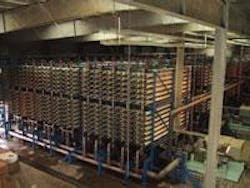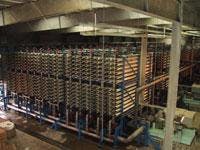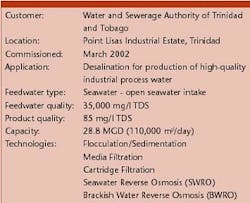SWRO desalination plant supplies high-quality water in Trinidad
By Stacy Rodriguez
Trinidad's desalination plant, the largest seawater reverse osmosis (SWRO) system in the Western Hemisphere, continues to supply low-cost, high-quality water for the Point Lisas Industrial Estate 24 hours a day, seven days a week since its initial start-up in March 2002.
Potable water supplies are limited on this Caribbean island, so the Water and Sewerage Authority (WASA) of Trinidad and Tobago decided to find a large-volume alternative to provide its growing industrial sector with a reliable water supply. WASA awarded an engineering, procurement and construction (EPC) contract to the US company Ionics, based in Watertown, Massachusetts, to provide a 28.8-mgd desalination facility at the large industrial complex located on the western shore of Trinidad.
Innovative SWRO design coupled with proven pretreatment technology in the plant is being used to desalinate a highly variable and turbid seawater source, the Gulf of Paria. The Trinidad desalination plant was developed under a long-term design, build, own, operate and transfer (BOOT) arrangement. Desalcott, a joint venture between Ionics and a local Trinidadian partner, Hafeez Karamath Engineering Services Limited, operates and maintains the facility.
A large ship-turning basin in Trinidad's Gulf of Paria provides seawater for the plant. Raw seawater is taken from a screened basin at the shoreline of the ship-turning basin and, due to the high amount of silt in the difficult-to-treat gulf water, enters an intensive pretreatment system consisting of coagulant mixing, clarification, single stage media filtration and cartridge filters. The heart of the desalination system is the Two Pass RO system, consisting of six Pass 1 SWRO units and six Pass 2 BWRO (brackish water) units.
The First Pass Seawater RO, consisting of six units, is a two-stage system. The First Pass first-stage configuration, a 7-element pressure vessel design, consists of a total of 1568 Toray SWHR-380 seawater membrane elements. The first stage pressure feed pump supplies the pressure required to treat the seawater. This works in conjunction with an ERT, which helps boost the SWRO feed pressure by converting the energy from the reject stream back to the feed.
The First Pass second-stage configuration consists of 980 Toray SWHR-380 seawater membrane elements. Due to the high concentration of salts, inter-stage booster pumps are required to boost the second-stage feed pressure. Permeate is delivered to a clearwell within the RO facility. The brine or reject is passed through the Pelton ERT and discharged at atmospheric pressure to a below grade drain that flows to a reject basin.
The Second Pass RO treats permeate from the SWRO to meet the final product quality specification of the water supply agreement. All of the first pass permeate is treated, and the number of units corresponds to the number of seawater units. The BWRO, which uses a total of 690 Toray SUL-G20F brackish water membrane elements, is also a two-stage system with a feed pump and inter stage booster pumps for each unit. Permeate from the BWRO is delivered to a 10-million-gallon storage tank located within the facility grounds. Reject is returned back to the clearwell and reintroduced as feed to the First Pass RO. Post treatment involves only pH adjustment, minimal remineralisation and disinfection. This is in accordance with standard potable water practices because, although the primary end users are the industrial clients within the Point Lisas Industrial Estate, WASA wanted to have the option of diverting the water supply to their residential customers as required.
Construction of the landmark desalination facility took just 18 months from commencing above ground civil works to production of water. Since its start-up in March 2002, this facility has been operating on virtually a 24/7 basis. The plant passed its Phase IV performance test in June 2002. The fifth phase of the contract begins March 2004 and is scheduled to add an additional 15% of capacity.
Author's NoteStacy Rodriguez is the marketing manager of Ionics, Incorporated, based in Watertown, Massachusetts, USA.


